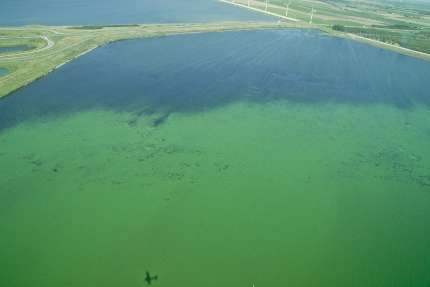Rising CO2 levels will intensify algal blooms across the globe

Rising CO2 concentrations in the atmosphere will stimulate harmful algal blooms at a global level. This warning is issued by scientists Jolanda Verspagen and Jef Huisman of the University of Amsterdam, The Netherlands, on the basis of new mathematical models, laboratory experiments and field research. Their results will be published open access in the scientific journal PLOS ONE.
Harmful algal blooms are a threat to the water quality of nutrient-rich ponds, lakes and reservoirs. Dense blooms may smother water plants and can lead to fish kills. Several harmful algal species can produce toxins causing serious and sometimes fatal liver, digestive and neurological
diseases in birds, mammals and humans. Harmful algal blooms are therefore a major concern in water quality management, and often lead to the closure of recreational waters.
Dutch scientists Verspagen and Huisman provide both theoretical and experimental evidence - based on research with toxic cyanobacteria – that algal blooms will intensify with rising CO2 levels. Algae require CO2 for photosynthesis and growth, and during bloom development they can deplete the CO2 concentration dissolved in water. Rising CO2 concentrations in the atmosphere enhance the influx of CO2 in lakes, which delays depletion of the dissolved CO2 in water, enabling algae to develop much higher population densities.
A global issue
Jolanda Verspagen: 'The novelty of our work is the tight combination of mathematical models and experiments. This approach allows detailed quantitative prediction of the complex feedbacks between algal growth and the availability of CO2 in water. Algae are responsible for about 50% of the global primary production of our planet. Such quantitative approaches are therefore highly needed.'
The model results show that algal blooms will intensify particularly in nutrient-rich waters. If all nutrients (such as nitrate and phosphate) are in sufficient supply, thenCO2 availability is the major controlling factor for the development of dense algal blooms.
'In essence, the rise in atmospheric CO2 concentrations is one big fertilization experiment at an unprecedented large scale. An enhanced CO2 influx into aquatic ecosystems is not just a problem for a few local lakes, it will intensify algal blooms in nutrient-rich waters across the globe. Water managers and policy makers will have to prepare for a deterioration of the water quality due to climate change', says professor Jef Huisman.
Nutrient-rich versus nutrient-poor waters
In a recent publication in Ecology Letters, last month, Verspagen and Huisman already demonstrated that rising CO2 levels will specifically intensify algal blooms in lakes and reservoirs with high nutrient loads. The response to rising CO2 is completely different in low-productive waters, where a lack of nutrients prevents the development of dense algal blooms. In nutrient-poor water, the carbon-to-nutrient ratio of algal biomass will increase with rising CO2 levels, which reduces the nutritional quality of algae as food for other organisms in the food chain.
Journal information: PLoS ONE , Ecology Letters
















